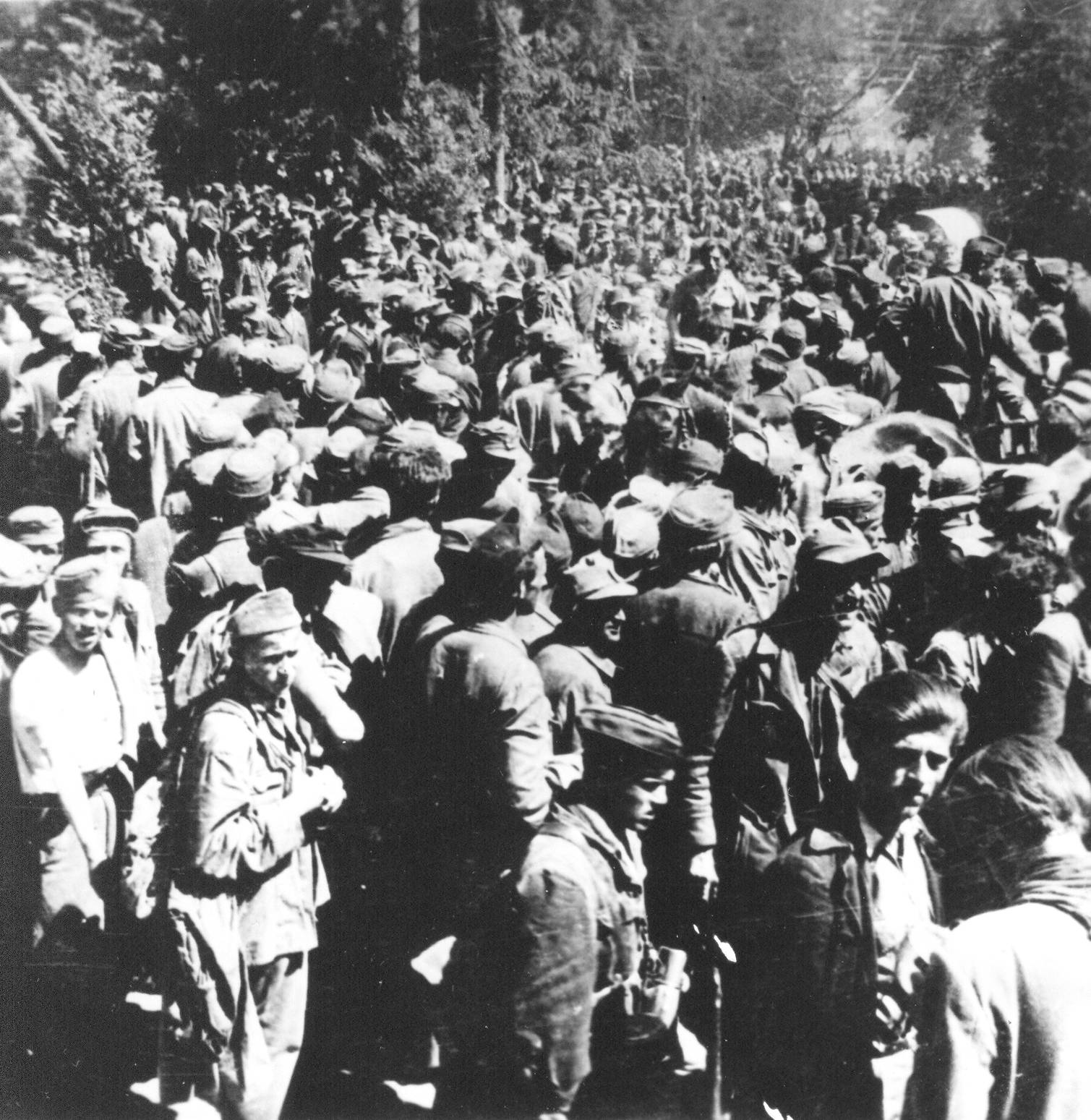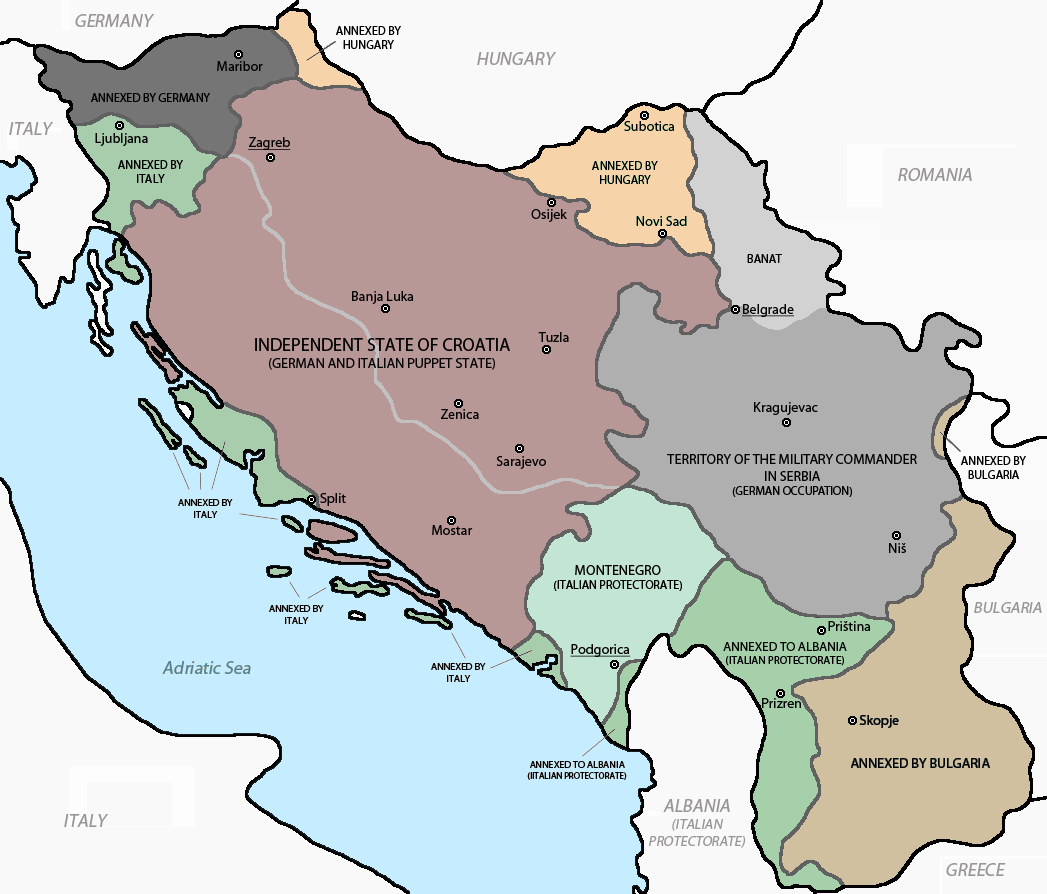|
Barbara Pit Massacre
The Barbara Pit massacre ( sl, Pokol v Barbara rovu, hr, Pokolj u Barbarinom rovu), also known as the Huda Jama massacre, was the mass killing of prisoners of war of Ante Pavelić's NDH Armed Forces and the Slovene Home Guard, as well as civilians, after the end of World War II in Yugoslavia in an abandoned coal mine near Huda Jama, Slovenia. More than a thousand prisoners of war and some civilians were executed by the Yugoslav Partisans during May and June 1945, following the Bleiburg repatriations by the British. The location of the massacre was then sealed with concrete barriers and discussion about it was forbidden. The mass grave site, one of the largest in Slovenia, was first publicly discussed in 1990, after the fall of communism in Yugoslavia. A memorial chapel was raised near the entrance to the mine in 1997. Investigation of the Barbara Pit mine began in 2008. It took several months for workers to remove concrete walls built after the war to seal the cave. On 3 March ... [...More Info...] [...Related Items...] OR: [Wikipedia] [Google] [Baidu] |
Bleiburg Repatriations
The Bleiburg repatriations ( see terminology) occurred in May 1945, after the end of World War II in Europe, during which Yugoslavia had been occupied by the Axis powers, when tens of thousands of soldiers and civilians associated with the Axis powers fled Yugoslavia to Austria as the Yugoslav Partisans took control. When they reached Allied-occupied Austria, the British refused to accept their surrender and directed them to the Partisans instead. The prisoners of war were subjected to forced marches, together with columns captured by other Partisans in Yugoslavia. Tens of thousands were executed; others were taken to forced labor camps, where more died from harsh conditions. The events are named for the Carinthian border town of Bleiburg, where the initial repatriation was carried out. On 3 May 1945, the government of the Independent State of Croatia (NDH), a fascist puppet state established in parts of German-occupied Yugoslavia, that had undertaken a brutal campaign of geno ... [...More Info...] [...Related Items...] OR: [Wikipedia] [Google] [Baidu] |
Maribor
Maribor ( , , , ; also known by other #Name, historical names) is the second-largest city in Slovenia and the largest city of the traditional region of Styria (Slovenia), Lower Styria. It is also the seat of the City Municipality of Maribor, the seat of the Drava Statistical Region, Drava statistical region and the Eastern Slovenia region. Maribor is also the economic, administrative, educational, and cultural centre of eastern Slovenia. Maribor was first mentioned as a castle in 1164, as a settlement in 1209, and as a city in 1254. Like most Slovene Lands, Slovene ethnic territory, Maribor was under Habsburg monarchy, Habsburg rule until 1918, when Rudolf Maister and his men secured the city for the State of Slovenes, Croats and Serbs, which then joined the Kingdom of Serbia to form the Kingdom of Yugoslavia. In 1991 Maribor became part of independent Slovenia. Maribor, along with the Portuguese city of Guimarães, was selected the European Capital of Culture for 2012. Name M ... [...More Info...] [...Related Items...] OR: [Wikipedia] [Google] [Baidu] |
Gottscheers
Gottscheers are the German settlers of the Kočevje, Kočevje region (a.k.a. Gottschee) of Slovenia, formerly Gottschee, Gottschee County. Until the World War II, Second World War, their main language of communication was Gottscheerish, a Bavarian language, Bavarian dialect of German. Origins They first settled in Carniola around 1330 from the German lands of County of Tyrol, Tyrol and Duchy of Carinthia, Carinthia and maintained their German identity and language during their 600 years of isolation. They cleared the vast forests of the region and established villages and towns. In 1809, they resisted the Illyrian Provinces, French annexation of the territory in the 1809 Gottscheer rebellion, Gottscheer Rebellion. With the end of the Habsburg monarchy in 1918, Gottschee became a part of the new Kingdom of Yugoslavia. The Gottscheers thus went from part of the ruling ethnicity of Austria-Hungary (and the ruling group in the estates of the province of Carniola itself) to an ethnic mi ... [...More Info...] [...Related Items...] OR: [Wikipedia] [Google] [Baidu] |
Kočevje
Kočevje (; german: Gottschee; ''Göttscheab'' or ''Gətscheab'' in the local Gottscheerish dialect; it, Cocevie) is a city in the Municipality of Kočevje in southern Slovenia. It is the seat of the municipality. Geography The town is located at the foot of the Kočevski Rog karst plateau on the Rinža River in the historic Lower Carniola region. It is now part of the Southeast Slovenia Statistical Region. The Rinža River flows through the town. Lake Kočejve, a former open-pit coal mine, lies northeast of the town center. Climate Kočevje features a humid continental climate (''Dfb''/''Cfb''). Name Kočevje was attested in written sources in 1363 as ''Gotsche'' (and as ''Gotsew'' in 1386, ''Kotsche'' in 1425, and ''propre Koczeuiam'' in 1478). The name is derived from ''*Hvojčevje'' (from ''hvoja'' 'fir, spruce'), referring to the local vegetation. The initial ''hv-'' changed to ''k-'' under the influence of German phonology. Older discredited explanations inclu ... [...More Info...] [...Related Items...] OR: [Wikipedia] [Google] [Baidu] |
Teharje Camp
The Teharje camp ( sl, taborišče Teharje) was a concentration camp near Teharje, Slovenia, organised by the Yugoslav secret police (OZNA) after the end of World War II in Yugoslavia. It was primarily used for the internment of Slovene Home Guard prisoners of war, ethnic Germans, and Slovene civilians. The camp was built in 1943 by German forces and was used as a military camp for Hitler Youth. It had six residential barracks and ten other buildings. The camp was abandoned for a short time after the war, but was reactivated by the Yugoslav communists at the end of May 1945 to accommodate former members of the Slovene Home Guard and others that had collaborated with the Axis, as well as civilians that had fled before the advancing Yugoslav People's Army to Allied camps in Austrian Carinthia. On 31 May 1945, the entire 2nd Assault Battalion of the Slovene Home Guard, headed by Vuk Rupnik, was brought to Teharje, and in the first days of June 1945 approximately 3,000 additional mem ... [...More Info...] [...Related Items...] OR: [Wikipedia] [Google] [Baidu] |
Dravograd
Dravograd (; german: Unterdrauburg) is a small town in northern Slovenia, close to the border with Austria. It is the seat of the Municipality of Dravograd. It lies on the Drava River at the confluence with the Meža and the Mislinja. It is part of the traditional Slovenian provinces of Carinthia and the larger Carinthia Statistical Region. History From 976 onwards the Dravograd area was part of the Duchy of Carinthia. The German name ''Unterdrauburg'' denoted the place where the Drava River left Carinthia and flowed into the neighbouring Duchy of Styria. It corresponded with Oberdrauburg up the river at Carinthia's western border with the County of Tyrol. The name Dravograd was invented during the Slovene national revival in the 19th century. Previously, the local Slovene name of the town was ''Traberk'', a derivative of the German name ''Drauburg''. The 19th century was a period of national awakening of the Carinthian Slovenes, and also of the rise of competing nation ... [...More Info...] [...Related Items...] OR: [Wikipedia] [Google] [Baidu] |
OZNA
The Department for People's Protection or OZNA ( sh-Cyrl-Latn, Одељење за заштиту нaрода, Odjeljenje za zaštitu naroda, Odeljenje za zaštitu naroda; mk, Одделение за заштита на народот; sl, Oddelek za zaščito naroda) was the security agency of Communist Yugoslavia that existed between 1944 and 1946. Founding The OZNA was founded on 13 May 1944 according to decision of Josip Broz Tito and under the leadership of Aleksandar Ranković (''nom de guerre'' Marko), a top member of the Politburo until his downfall in 1966, and a close associate of Josip Broz Tito. On 24 May 1944, only a day before the Operation Rösselsprung, Tito signed the Military Courts Regulations ( sh, Uredba o vojnim sudovima NOVJ), which in article number 27 stated that the court reaches its decisions whether the accused are guilty or not based on its free evaluation, regardless of the evidence. Based on the investigations performed by the OZNA, the military co ... [...More Info...] [...Related Items...] OR: [Wikipedia] [Google] [Baidu] |
Bleiburg
Bleiburg ( sl, Pliberk) is a small town in the south Austrian state of Carinthia (''Koroška''), south-east of Klagenfurt, in the district of Völkermarkt, some four kilometres (2.5 miles) from the border with Slovenia. The municipality consists of the twelve ''Katastralgemeinden'' Aich (''Dob''), Bleiburg, Grablach (''Grablje''), Kömmel (''Komelj''), Moos (''Blato''), Oberloibach (''Libuče''), Rinkenberg (''Vogrče''), Sankt Margarethen (''Šmarjeta''), Schattenberg (''Senčni kraj''), Unterloibach (''Libuče''), Weißenstein (''Belšak'') and Woroujach (''Borovje''). According to a 2001 census, 30.4% of the population are Carinthian Slovenes (in 1971, they were 52.8%). Geography The border town is located in the valley of the Feistritz creek, a right tributary of the Drava, north of the Peca massif of the Karavanke mountain range. It is home to a district court, military barracks and to the local productive and services industry. The name of Bleiburg, literally meaning 'Le ... [...More Info...] [...Related Items...] OR: [Wikipedia] [Google] [Baidu] |
Allies Of World War II
The Allies, formally referred to as the United Nations from 1942, were an international military coalition formed during the Second World War (1939–1945) to oppose the Axis powers, led by Nazi Germany, Imperial Japan, and Fascist Italy. Its principal members by 1941 were the United Kingdom, United States, Soviet Union, and China. Membership in the Allies varied during the course of the war. When the conflict broke out on 1 September 1939, the Allied coalition consisted of the United Kingdom, France, and Poland, as well as their respective dependencies, such as British India. They were soon joined by the independent dominions of the British Commonwealth: Canada, Australia, New Zealand and South Africa. Consequently, the initial alliance resembled that of the First World War. As Axis forces began invading northern Europe and the Balkans, the Allies added the Netherlands, Belgium, Norway, Greece, and Yugoslavia. The Soviet Union, which initially had a nonaggression pa ... [...More Info...] [...Related Items...] OR: [Wikipedia] [Google] [Baidu] |
Axis Powers
The Axis powers, ; it, Potenze dell'Asse ; ja, 枢軸国 ''Sūjikukoku'', group=nb originally called the Rome–Berlin Axis, was a military coalition that initiated World War II and fought against the Allies. Its principal members were Nazi Germany, the Kingdom of Italy, and the Empire of Japan. The Axis were united in their opposition to the Allies, but otherwise lacked comparable coordination and ideological cohesion. The Axis grew out of successive diplomatic efforts by Germany, Italy, and Japan to secure their own specific expansionist interests in the mid-1930s. The first step was the protocol signed by Germany and Italy in October 1936, after which Italian leader Benito Mussolini declared that all other European countries would thereafter rotate on the Rome–Berlin axis, thus creating the term "Axis". The following November saw the ratification of the Anti-Comintern Pact, an anti-communist treaty between Germany and Japan; Italy joined the Pact in 1937, follow ... [...More Info...] [...Related Items...] OR: [Wikipedia] [Google] [Baidu] |







